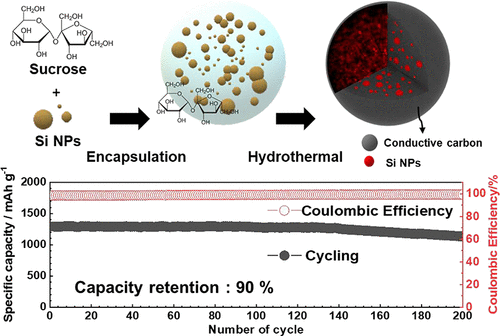当前位置:
X-MOL 学术
›
ACS Sustain. Chem. Eng.
›
论文详情
Our official English website, www.x-mol.net, welcomes your feedback! (Note: you will need to create a separate account there.)
Sustainable Encapsulation Strategy of Silicon Nanoparticles in Microcarbon Sphere for High-Performance Lithium-Ion Battery Anode
ACS Sustainable Chemistry & Engineering ( IF 8.4 ) Pub Date : 2020-08-24 , DOI: 10.1021/acssuschemeng.0c04828 Hyeon-Ji Shin 1, 2 , Jang-Yeon Hwang 3 , Hyun Jung Kwon 1, 4 , Won-Jin Kwak 5 , Sang-Ok Kim 1, 2 , Hyung-Seok Kim 1 , Hun-Gi Jung 1, 2
ACS Sustainable Chemistry & Engineering ( IF 8.4 ) Pub Date : 2020-08-24 , DOI: 10.1021/acssuschemeng.0c04828 Hyeon-Ji Shin 1, 2 , Jang-Yeon Hwang 3 , Hyun Jung Kwon 1, 4 , Won-Jin Kwak 5 , Sang-Ok Kim 1, 2 , Hyung-Seok Kim 1 , Hun-Gi Jung 1, 2
Affiliation

|
Owing to the high theoretical capacity, low operating potentials, and natural abundance, silicon (Si) is considered as one of the most promising anode materials for lithium-ion batteries. However, a large volume change during alloying–dealloying often results in pulverization, electrical contact loss, and unstable solid-electrolyte interphase (SEI) formation, leading to rapid capacity fading. We present a rational encapsulation strategy of a silicon–carbon (Si–C) composite as a high-performance anode material for lithium-ion batteries (LIBs). The Si–C composite material is prepared via a one-pot hydrothermal method by using silicon nanoparticles modified using an etching route and sucrose as a carbon precursor. The proposed Si–C composite material has a meso-macroporous structure and contains a large weight fraction of silicon nanoparticles (40 wt %) encapsulated in a micrometric carbon sphere (∼3 μm). In the composite material, the carbon framework tightly encapsulates the silicon nanoparticles to the interior of the particle, which not only provides electrical conductivity but also decreases the stress/strain of the material during the alloying–dealloying process. The material demonstrates high initial capacity of 1300 mAh g–1, excellent capacity retention of 90% after 200 cycles, and fast charging–discharging capability within 12 min. We believe that the proposed encapsulation strategy here will be helpful in developing a high-energy and low-cost Si–C composite anode.
中文翻译:

高性能锂离子电池阳极微碳球中硅纳米颗粒的可持续封装策略
由于高理论容量,低工作电位和自然丰度,硅(Si)被认为是锂离子电池最有希望的负极材料之一。但是,合金化和脱合金过程中的大量体积变化通常会导致粉碎,电接触损耗和不稳定的固体电解质中间相(SEI)形成,从而导致容量快速衰减。我们提出了一种硅碳(Si-C)复合材料作为锂离子电池(LIB)高性能阳极材料的合理封装策略。硅碳复合材料是通过一锅法水热法制备的,使用的是经过刻蚀途径改性的硅纳米颗粒和蔗糖作为碳前体。拟议的Si-C复合材料具有介孔结构,并且包含很大一部分硅纳米颗粒(40 wt%)封装在微米级碳球中(〜3μm)。在复合材料中,碳骨架将硅纳米颗粒紧密封装在颗粒内部,这不仅提供了导电性,还降低了合金脱合金过程中材料的应力/应变。该材料显示出1300 mAh g的高初始容量–1,200次循环后具有出色的90%容量保持能力,并在12分钟内具有快速充放电能力。我们认为,此处提出的封装策略将有助于开发高能,低成本的Si-C复合阳极。
更新日期:2020-09-21
中文翻译:

高性能锂离子电池阳极微碳球中硅纳米颗粒的可持续封装策略
由于高理论容量,低工作电位和自然丰度,硅(Si)被认为是锂离子电池最有希望的负极材料之一。但是,合金化和脱合金过程中的大量体积变化通常会导致粉碎,电接触损耗和不稳定的固体电解质中间相(SEI)形成,从而导致容量快速衰减。我们提出了一种硅碳(Si-C)复合材料作为锂离子电池(LIB)高性能阳极材料的合理封装策略。硅碳复合材料是通过一锅法水热法制备的,使用的是经过刻蚀途径改性的硅纳米颗粒和蔗糖作为碳前体。拟议的Si-C复合材料具有介孔结构,并且包含很大一部分硅纳米颗粒(40 wt%)封装在微米级碳球中(〜3μm)。在复合材料中,碳骨架将硅纳米颗粒紧密封装在颗粒内部,这不仅提供了导电性,还降低了合金脱合金过程中材料的应力/应变。该材料显示出1300 mAh g的高初始容量–1,200次循环后具有出色的90%容量保持能力,并在12分钟内具有快速充放电能力。我们认为,此处提出的封装策略将有助于开发高能,低成本的Si-C复合阳极。



























 京公网安备 11010802027423号
京公网安备 11010802027423号